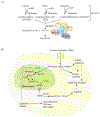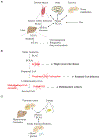Emerging Roles for Branched-Chain Amino Acid Metabolism in Cancer
- PMID: 32049045
- PMCID: PMC7082774
- DOI: 10.1016/j.ccell.2019.12.011
Emerging Roles for Branched-Chain Amino Acid Metabolism in Cancer
Abstract
Metabolic pathways must be adapted to support cell processes required for transformation and cancer progression. Amino acid metabolism is deregulated in many cancers, with changes in branched-chain amino acid metabolism specifically affecting cancer cell state as well as systemic metabolism in individuals with malignancy. This review highlights key concepts surrounding the current understanding of branched-chain amino acid metabolism and its role in cancer.
Keywords: branched-chain amino acids; cancer metabolism; epigenetics; metabolism.
Copyright © 2020 Elsevier Inc. All rights reserved.
Figures



References
-
- Ananieva EA, Bostic JN, Torres AA, Glanz HR, McNitt SM, Brenner MK, Boyer MP, Addington AK, and Hutson SM (2018). Mice deficient in the mitochondrial branched-chain aminotransferase (BCATm) respond with delayed tumour growth to a challenge with EL-4 lymphoma. Br. J. Cancer 119, 1009–1017. - PMC - PubMed
-
- Arany Z, and Neinast M (2018). Branched Chain Amino Acids in Metabolic Disease. Curr. Diab. Rep 3–8. - PubMed
Publication types
MeSH terms
Substances
Grants and funding
LinkOut - more resources
Full Text Sources
Medical

